Deck 13: Graph Theory
Question
Question
Question
Question
Question
Question
Question
Question
Question
Question
Question
Question
Question
Question
Question
Question
Question
Question
Question
Question
Question
Question
Question
Question
Question
Question
Question
Question
Question
Question
Question
Question
Question
Question
Question
Question
Question
Question
Question
Question
Question
Question
Question
Question
Question
Question
Question
Question
Question
Question
Question
Question
Question
Question
Question
Question
Question
Question

Unlock Deck
Sign up to unlock the cards in this deck!
Unlock Deck
Unlock Deck
1/58
Play
Full screen (f)
Deck 13: Graph Theory
1
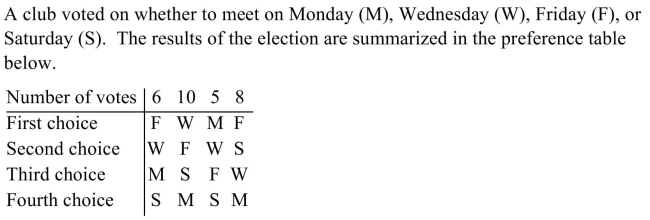 (a) Using the pairwise comparison voting method, determine the winner. (b) If candidate S is eliminated and the votes are recounted, does this election violate the irrelevant alternative criterion?
(a) Using the pairwise comparison voting method, determine the winner. (b) If candidate S is eliminated and the votes are recounted, does this election violate the irrelevant alternative criterion?(a) W
(b) No. W still wins.
(b) No. W still wins.
2
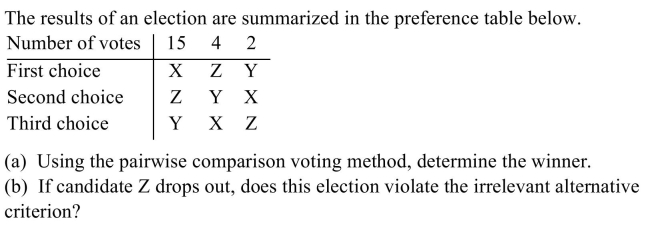
(a) X
(b) No, the winner is still X.
(b) No, the winner is still X.
3
 (a) How many people voted? (b) Determine the winner using the plurality method.
(a) How many people voted? (b) Determine the winner using the plurality method.(a) 30
(b) S
(b) S
4
 Is the monotonicity criterion violated? Explain your answer.
Is the monotonicity criterion violated? Explain your answer.
Unlock Deck
Unlock for access to all 58 flashcards in this deck.
Unlock Deck
k this deck
5
 Does the election violate the majority criterion? Explain your answer.
Does the election violate the majority criterion? Explain your answer.
Unlock Deck
Unlock for access to all 58 flashcards in this deck.
Unlock Deck
k this deck
6
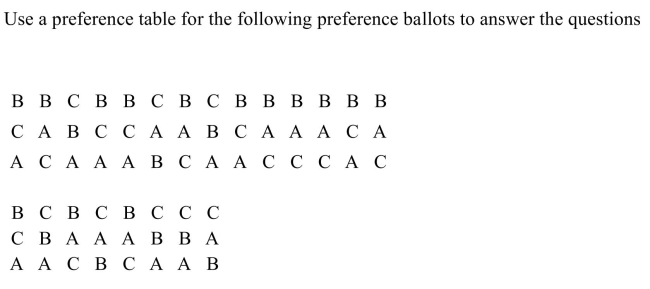 (a) How many people voted? (b) How many people voted for the candidates in the order of preference BCA? (c) How many people voted for candidate B for their first choice?
(a) How many people voted? (b) How many people voted for the candidates in the order of preference BCA? (c) How many people voted for candidate B for their first choice?
Unlock Deck
Unlock for access to all 58 flashcards in this deck.
Unlock Deck
k this deck
7
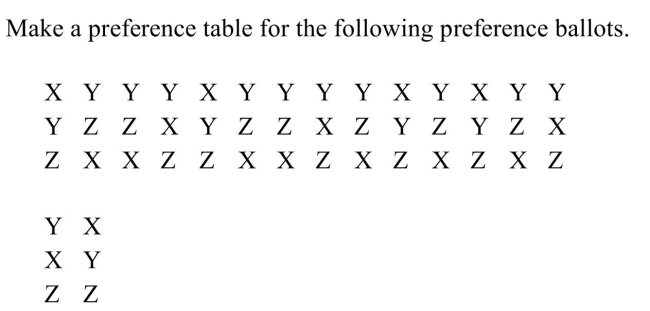

Unlock Deck
Unlock for access to all 58 flashcards in this deck.
Unlock Deck
k this deck
8


Unlock Deck
Unlock for access to all 58 flashcards in this deck.
Unlock Deck
k this deck
9
 (a) Using the pairwise comparison voting method, determine the winner. (b) If candidate X drops out and the votes are recounted, does this election violate the irrelevant alternative criterion?
(a) Using the pairwise comparison voting method, determine the winner. (b) If candidate X drops out and the votes are recounted, does this election violate the irrelevant alternative criterion?
Unlock Deck
Unlock for access to all 58 flashcards in this deck.
Unlock Deck
k this deck
10
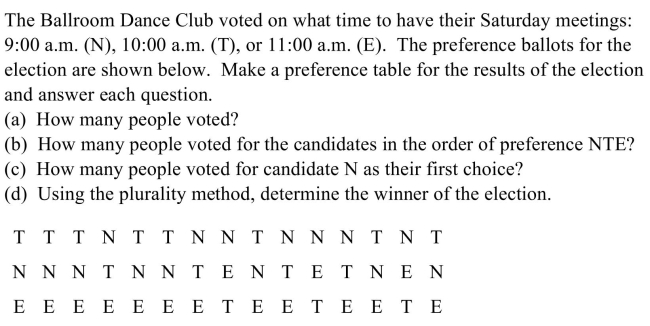

Unlock Deck
Unlock for access to all 58 flashcards in this deck.
Unlock Deck
k this deck
11
 (a) Using the Borda count method of voting, determine the winner. (b) Does the election violate the majority criterion?
(a) Using the Borda count method of voting, determine the winner. (b) Does the election violate the majority criterion?
Unlock Deck
Unlock for access to all 58 flashcards in this deck.
Unlock Deck
k this deck
12
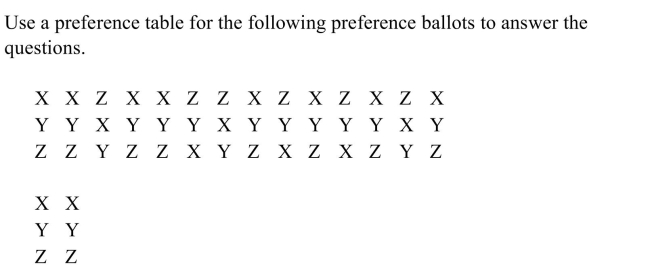 (a) How many people voted? (b) How many people voted for the candidates in the order of preference ZYX? (c) How many people voted for candidate X for their first choice?
(a) How many people voted? (b) How many people voted for the candidates in the order of preference ZYX? (c) How many people voted for candidate X for their first choice?
Unlock Deck
Unlock for access to all 58 flashcards in this deck.
Unlock Deck
k this deck
13


Unlock Deck
Unlock for access to all 58 flashcards in this deck.
Unlock Deck
k this deck
14
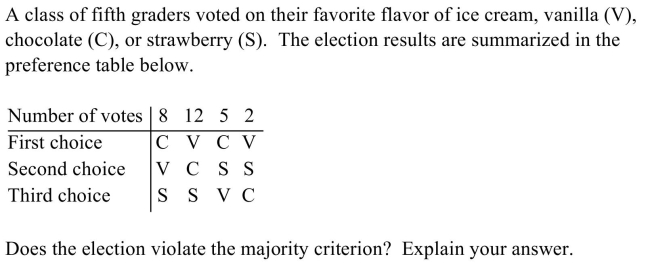

Unlock Deck
Unlock for access to all 58 flashcards in this deck.
Unlock Deck
k this deck
15


Unlock Deck
Unlock for access to all 58 flashcards in this deck.
Unlock Deck
k this deck
16
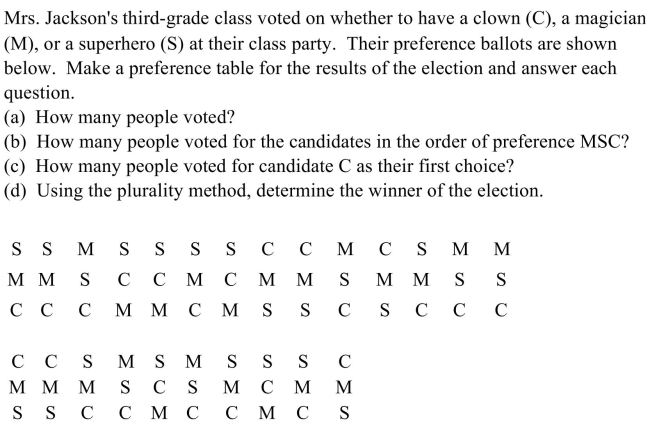

Unlock Deck
Unlock for access to all 58 flashcards in this deck.
Unlock Deck
k this deck
17
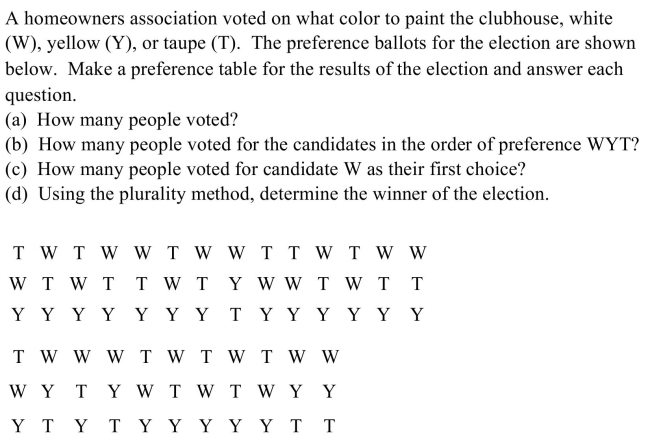

Unlock Deck
Unlock for access to all 58 flashcards in this deck.
Unlock Deck
k this deck
18
If there are 7 candidates in an election, how many pairwise comparisons need to be made in order to determine a winner?

Unlock Deck
Unlock for access to all 58 flashcards in this deck.
Unlock Deck
k this deck
19


Unlock Deck
Unlock for access to all 58 flashcards in this deck.
Unlock Deck
k this deck
20
 (a) Using the Borda count method of voting, determine the winner. (b) Does the election violate the majority criterion?
(a) Using the Borda count method of voting, determine the winner. (b) Does the election violate the majority criterion?
Unlock Deck
Unlock for access to all 58 flashcards in this deck.
Unlock Deck
k this deck
21
The results of an election are summarized in the preference table below.
Using the plurality-with-elimination method of voting, determine the winner.
A) D
B) A
C) C
D) B
Using the plurality-with-elimination method of voting, determine the winner.
A) D
B) A
C) C
D) B

Unlock Deck
Unlock for access to all 58 flashcards in this deck.
Unlock Deck
k this deck
22
The results of an election are summarized in the following preference table. If the plurality method is used, determine whether the head-to-head comparison criterion has been violated and explain why.
A) No, because X is the plurality winner.
B) Yes, because X does not win over Z in a head-to-head comparison.
C) Yes, because X does not win over Y in a head-to-head comparison.
D) No, because X wins over Y and Z in a head-to-head comparison.
A) No, because X is the plurality winner.
B) Yes, because X does not win over Z in a head-to-head comparison.
C) Yes, because X does not win over Y in a head-to-head comparison.
D) No, because X wins over Y and Z in a head-to-head comparison.

Unlock Deck
Unlock for access to all 58 flashcards in this deck.
Unlock Deck
k this deck
23
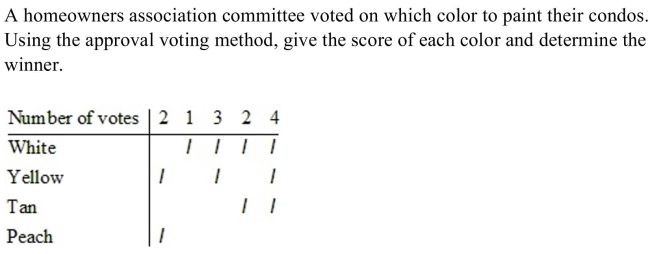

Unlock Deck
Unlock for access to all 58 flashcards in this deck.
Unlock Deck
k this deck
24
Use a preference table for the following preference ballots to determine the winner of the election using the plurality method.
A) Candidate B wins.
B) Candidates A and B tie.
C) Candidate A wins.
D) Candidate C wins.
A) Candidate B wins.
B) Candidates A and B tie.
C) Candidate A wins.
D) Candidate C wins.

Unlock Deck
Unlock for access to all 58 flashcards in this deck.
Unlock Deck
k this deck
25
 (a) Determine the winner using the Borda method of voting. (b) Is the winner the same as the one determined by the plurality method?
(a) Determine the winner using the Borda method of voting. (b) Is the winner the same as the one determined by the plurality method?
Unlock Deck
Unlock for access to all 58 flashcards in this deck.
Unlock Deck
k this deck
26


Unlock Deck
Unlock for access to all 58 flashcards in this deck.
Unlock Deck
k this deck
27
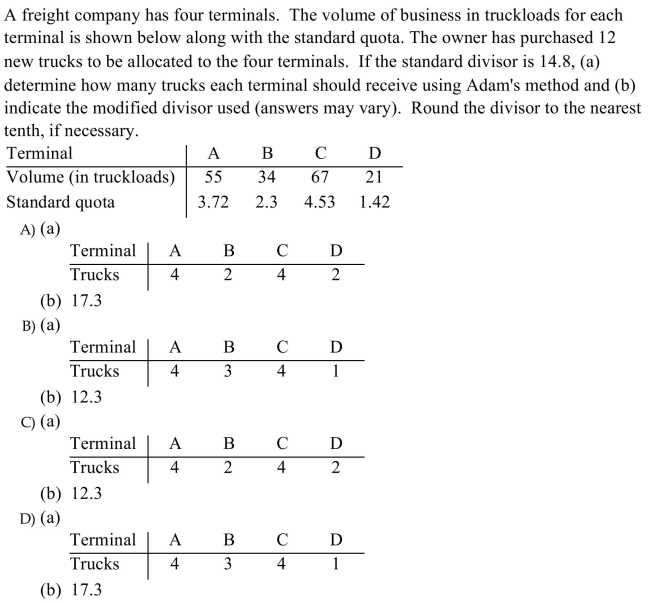

Unlock Deck
Unlock for access to all 58 flashcards in this deck.
Unlock Deck
k this deck
28
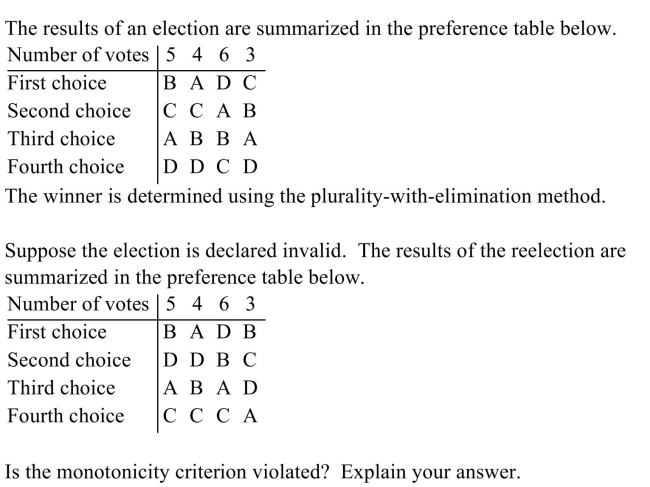

Unlock Deck
Unlock for access to all 58 flashcards in this deck.
Unlock Deck
k this deck
29
The results of an election are summarized in the following preference table. Determine the winner using the plurality method.
A) J
B) Tie between K and L
C) L
D) K
A) J
B) Tie between K and L
C) L
D) K

Unlock Deck
Unlock for access to all 58 flashcards in this deck.
Unlock Deck
k this deck
30


Unlock Deck
Unlock for access to all 58 flashcards in this deck.
Unlock Deck
k this deck
31
 (a) Determine the winner using the Borda method of voting. (b) Is the winner the same as the one determined by the plurality method?
(a) Determine the winner using the Borda method of voting. (b) Is the winner the same as the one determined by the plurality method?
Unlock Deck
Unlock for access to all 58 flashcards in this deck.
Unlock Deck
k this deck
32
A hiring board must select a new teacher. They vote using the approval method. The results are shown.
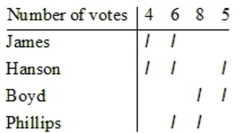
Which applicant was selected?
A) Phillips
B) James
C) Hanson
D) Boyd

Which applicant was selected?
A) Phillips
B) James
C) Hanson
D) Boyd

Unlock Deck
Unlock for access to all 58 flashcards in this deck.
Unlock Deck
k this deck
33
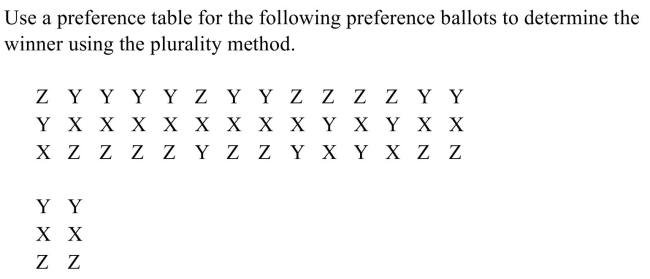

Unlock Deck
Unlock for access to all 58 flashcards in this deck.
Unlock Deck
k this deck
34
The results of an election are summarized in the preference table below.
Using the plurality-with-elimination method of voting, determine the winner.
A) Y
B) X
C) W
D) Z
Using the plurality-with-elimination method of voting, determine the winner.
A) Y
B) X
C) W
D) Z

Unlock Deck
Unlock for access to all 58 flashcards in this deck.
Unlock Deck
k this deck
35
The results of an election are summarized in the preference table below.
Using the pairwise comparison voting method, determine the winner.
A) C
B) A
C) B
Using the pairwise comparison voting method, determine the winner.
A) C
B) A
C) B

Unlock Deck
Unlock for access to all 58 flashcards in this deck.
Unlock Deck
k this deck
36
A county library has three branches. The number of books at each branch of the library is shown below. The head librarian purchased 49 new books and apportioned them to the libraries using Hamilton's method. When the book order arrived the librarian noticed there was an extra book added as a "bonus" and she reapportioned the books with the extra book added. Determine if the reapportionment resulted in the Alabama paradox
A) Alabama paradox did not occur
B) Alabama paradox occurred
A) Alabama paradox did not occur
B) Alabama paradox occurred

Unlock Deck
Unlock for access to all 58 flashcards in this deck.
Unlock Deck
k this deck
37
A city with three districts has an increase in population as indicated in the table, Using Hamilton's method, apportion the 30 seats between the three districts both before and after the population increase. Look at the percent increase in population for each district to determine if the population paradox occurred.
A) population paradox occurred
B) population paradox did not occur
A) population paradox occurred
B) population paradox did not occur

Unlock Deck
Unlock for access to all 58 flashcards in this deck.
Unlock Deck
k this deck
38

A) No. In a head-to-head comparison Z won over C and W.
B) Yes. In a head-to-head comparison Z won over W but lost to C.
C) No. Z is the plurality winner.
D) Yes. In a head-to-head comparison Z won over C but lost to W.

Unlock Deck
Unlock for access to all 58 flashcards in this deck.
Unlock Deck
k this deck
39


Unlock Deck
Unlock for access to all 58 flashcards in this deck.
Unlock Deck
k this deck
40
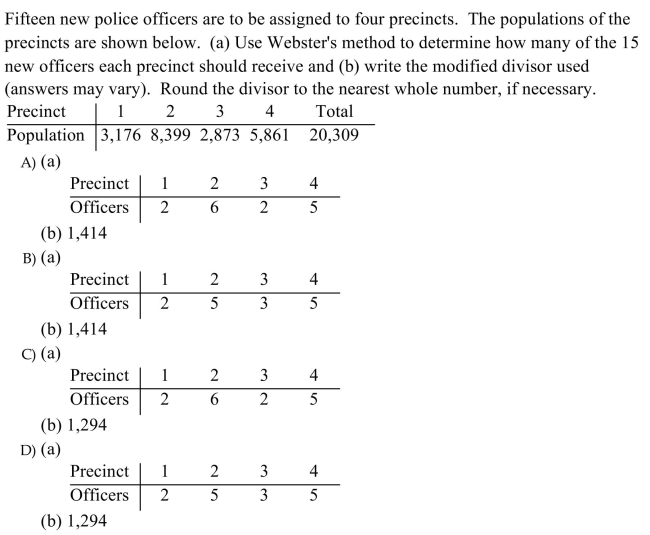

Unlock Deck
Unlock for access to all 58 flashcards in this deck.
Unlock Deck
k this deck
41
The preference table below summarizes the results of an election.
Using the Borda count method of voting, determine the winner.
A) Q
B) F
C) M
D) L
Using the Borda count method of voting, determine the winner.
A) Q
B) F
C) M
D) L

Unlock Deck
Unlock for access to all 58 flashcards in this deck.
Unlock Deck
k this deck
42
The math department is voting for a new department chairperson. The candidates are Jenkins (J), Peterson (P), and Thomas (T). The results of the election are summarized in the preference table below.
Using the plurality-with-elimination method of voting, determine the winner.
A) Peterson (P)
B) Thomas (T)
C) Jenkins (J)
Using the plurality-with-elimination method of voting, determine the winner.
A) Peterson (P)
B) Thomas (T)
C) Jenkins (J)

Unlock Deck
Unlock for access to all 58 flashcards in this deck.
Unlock Deck
k this deck
43


Unlock Deck
Unlock for access to all 58 flashcards in this deck.
Unlock Deck
k this deck
44

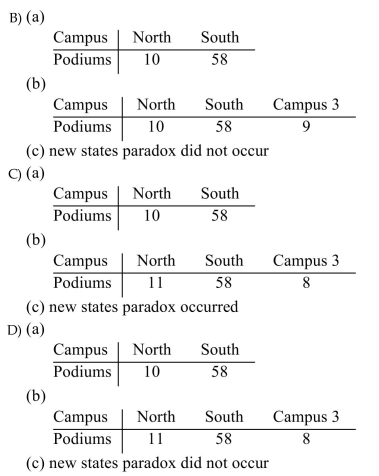

Unlock Deck
Unlock for access to all 58 flashcards in this deck.
Unlock Deck
k this deck
45
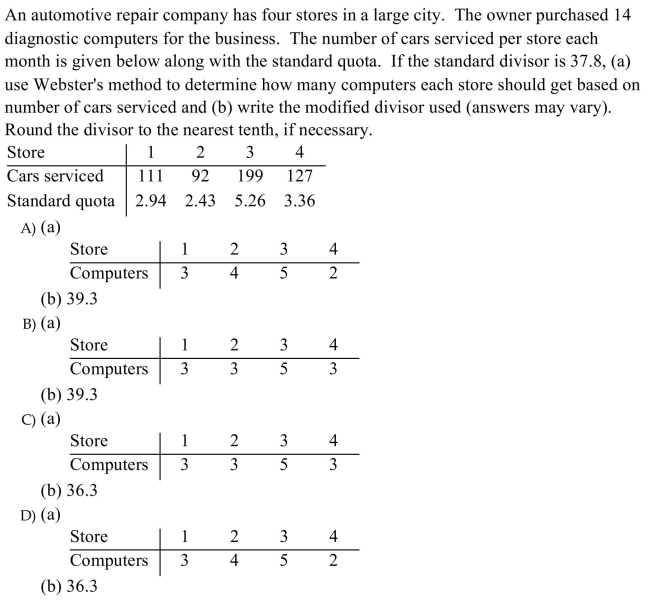

Unlock Deck
Unlock for access to all 58 flashcards in this deck.
Unlock Deck
k this deck
46
A club voted on what time to have their next meeting p.m., p.m., 5:00 p.m., or 6:00 p.m.). The election results are summarized in the preference table below.
Using the Borda count method of voting, determine the winner.
A) 6:00 p.m.
B) 12:00 p.m.
C) 5:00 p.m.
D) 1:00 p.m.
Using the Borda count method of voting, determine the winner.
A) 6:00 p.m.
B) 12:00 p.m.
C) 5:00 p.m.
D) 1:00 p.m.

Unlock Deck
Unlock for access to all 58 flashcards in this deck.
Unlock Deck
k this deck
47
The results of an election are summarized in the preference table below.
Using the plurality-with-elimination method of voting, determine the winner.
A) X
B) Z
C) Y
Using the plurality-with-elimination method of voting, determine the winner.
A) X
B) Z
C) Y

Unlock Deck
Unlock for access to all 58 flashcards in this deck.
Unlock Deck
k this deck
48
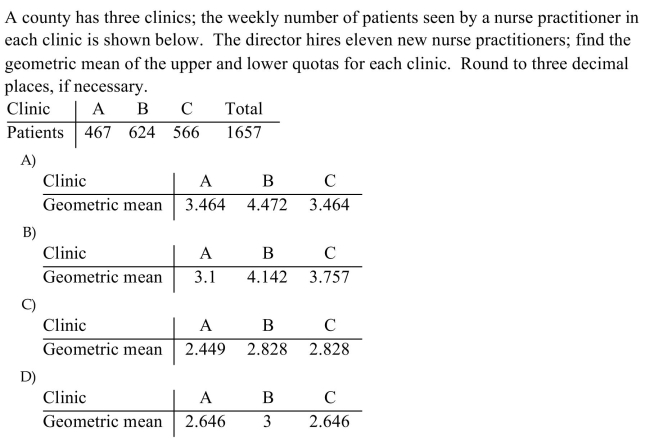

Unlock Deck
Unlock for access to all 58 flashcards in this deck.
Unlock Deck
k this deck
49
A committee must select one of its members to serve as president. They vote using the approval method. The results are shown.
Who was selected to be president of the committee?
A) Robinson
B) Green
C) Morgan
D) Park
Who was selected to be president of the committee?
A) Robinson
B) Green
C) Morgan
D) Park

Unlock Deck
Unlock for access to all 58 flashcards in this deck.
Unlock Deck
k this deck
50
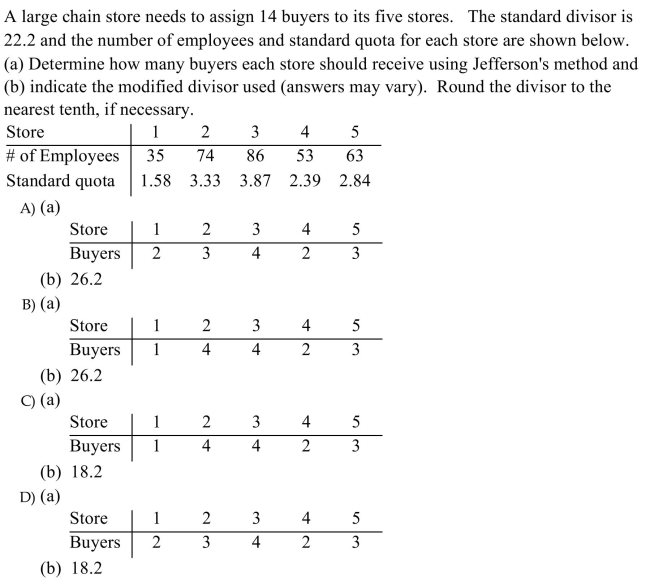

Unlock Deck
Unlock for access to all 58 flashcards in this deck.
Unlock Deck
k this deck
51
A tenure board must select one teacher to get tenure. They vote using the approval method. The results are shown.
Which teacher was selected?
A) Stewart
B) Wong
C) Luby
D) Davis
Which teacher was selected?
A) Stewart
B) Wong
C) Luby
D) Davis

Unlock Deck
Unlock for access to all 58 flashcards in this deck.
Unlock Deck
k this deck
52
A class of fifth graders voted on their favorite flavor of ice cream, vanilla , chocolate , or strawberry . The election results are summarized in the preference table below.
Using the Borda count method of voting, determine the winner.
A) Vanilla (V)
B) Strawberry (S)
C) Chocolate (C)
Using the Borda count method of voting, determine the winner.
A) Vanilla (V)
B) Strawberry (S)
C) Chocolate (C)

Unlock Deck
Unlock for access to all 58 flashcards in this deck.
Unlock Deck
k this deck
53


Unlock Deck
Unlock for access to all 58 flashcards in this deck.
Unlock Deck
k this deck
54
The results of an election are summarized in the preference table below.
Using the plurality-with-elimination method of voting, determine the winner.
A) A
B) C
C) B
D) D
Using the plurality-with-elimination method of voting, determine the winner.
A) A
B) C
C) B
D) D

Unlock Deck
Unlock for access to all 58 flashcards in this deck.
Unlock Deck
k this deck
55


Unlock Deck
Unlock for access to all 58 flashcards in this deck.
Unlock Deck
k this deck
56
The math department is voting for a new department chairperson. The candidates are Jenkins (J), Peterson (P), and Thomas (T). The results of the election are summarized in the preference table below.
The winner is determined by the plurality-with-elimination method. Suppose the election is declared invalid, and that a reelection is held. If the voters in column 2 change their vote from JPT to PJT, is the monotonicity criterion violated?
A) Yes
B) No
The winner is determined by the plurality-with-elimination method. Suppose the election is declared invalid, and that a reelection is held. If the voters in column 2 change their vote from JPT to PJT, is the monotonicity criterion violated?
A) Yes
B) No

Unlock Deck
Unlock for access to all 58 flashcards in this deck.
Unlock Deck
k this deck
57
If there are 6 candidates in an election, how many pairwise comparisons need to be made in order to determine a winner?
A) 6
B) 30
C) 21
D) 15
A) 6
B) 30
C) 21
D) 15

Unlock Deck
Unlock for access to all 58 flashcards in this deck.
Unlock Deck
k this deck
58
The results of an election are summarized in the preference table below.
Suppose the election is declared invalid, and a reelection is held. If the people who voted in the original election change their vote to , is the monotonicity criterion violated?
A) No
B) Yes
Suppose the election is declared invalid, and a reelection is held. If the people who voted in the original election change their vote to , is the monotonicity criterion violated?
A) No
B) Yes

Unlock Deck
Unlock for access to all 58 flashcards in this deck.
Unlock Deck
k this deck



